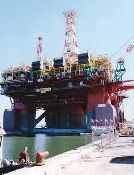What's happening in production
Alaska’s future productionIn response to a letter from Senator Frank Murkowski, Chairman of the U.S. Senate Committee on Energy and Natural Resources, requesting an EIA Service Report "with plausible scenarios for ANWR supply development consistent with the most recent U.S. Geological Survey resource assessments," the EIA released, in May, Potential Oil Production from the Coastal Plain of the Arctic National Wildlife Refuge: Updated Assessment. The agency’s usual analysis of Alaska North Slope potential has focused on areas without E&P restrictions. It now focuses on the Arctic National Wildlife Refuge (ANWR) coastal plain – a region currently restricted from E&P – and updates EIA’s 1987 ANWR assessment. The report contains projections of future, daily production rates using recent USGS resource estimates. The Coastal Plain study area includes 1.5 million acres in the ANWR 1002 Area, 92,000 acres of Native Inupiat lands and State of Alaska offshore lands out to the three-mile limit, that are expected to be explored and developed if, and when, ANWR is developed. About 26% of the technically recoverable oil resources are in Native and State lands. The Coastal Plain region comprises roughly 8% of the 19 million-acre ANWR and lies along the geologic trend that is productive in the Prudhoe Bay area 60 mi to the west. This is the largest unexplored, potentially productive onshore basin in the U.S. The 1002 Area is now closed to E&P, although Native and State lands are open. USGS made the following estimates of recoverable oil and NGLs from the ANWR Coastal Plain in 1998: There is a 95% probability that at least 5.7 billion bbl of oil are recoverable, a 5% probability of at least 16 billion bbl of recoverable oil, and a mean estimate of 10.3 billion bbl of recoverable oil. By comparison, total 1998 U.S. proved crude reserves were 21 billion bbl. The report postulates two production rates for each of the three USGS probability estimates without specifying oil-price or technology-advancement effects. The commercially developable resources associated with the three probability cases are calculated based on a 12% rate of return. Peak production rates for the six cases (two production rates ´ three probability estimates) were projected to range between 600,000 and 1.9 million bopd, with peak production estimated to occur 20 – 30 years after first oil. Although production infrastructure is nearby, it would take an estimated 7 to 12 years – from approval to explore to first production – for ANWR lease sales, permitting and environmental reviews. The study uses nine years, to 2010. Economic analysis of the ANWR 1002 Area indicates that, once oil has been discovered, more than 80% of the recoverable oil is commercially developable at an oil price of $25 per barrel. For reference, imported refiner-acquisition cost in 2020 is projected in EIA’s Annual Energy Outlook 2000 reference case at $22.04 per bbl (1998 dollars). At this price, potential ANWR oil production would have a value between $125 and $350 billion (1998 dollars). Specific information about the report may be obtained from Floyd Wiesepape: (214) 720-6166 or floyd.wiesepape@eia.doe.gov.
World’s deepest and largest. In mid-May, Petrobrás-36 began production in Roncador field from Well RO-9 at a rate of 1,700 bopd. An undisclosed amount of gas is also being produced, compressed and transported to shore via pipeline. This is a water-depth production record from a floating production facility (FPF). Weighing 56,000 t, Petrobrás-36 is also the world’s largest semi-sub FPF. It has a production capacity of 180,000 bopd and 89 oil-extraction flowlines, each more than 4,500 ft long. It can gather oil from 29 different subsea wells. The floater is an upgrade of the Spirit of Columbus. Noble Denton Europe Ltd. was the engineering contractor for major hull and deck modifications, as well as the mooring system, riser supports and riser pull-in system. Davies Industries and Maritima were also major contractors for the rebuild. New Canadian production. Chevron Canada Resources and partners began first production from the K-29 discovery well, located 18 mi NW of Fort Laird, Northwest Territories. Initial production of 35 MMcfgd will be ramped up to about 75 MMcfgd over a 10-day period. A new 35-mi pipeline will bring this gas to a pipeline at Pointed Mountain. Production from Chevron’s second well, M-25, drilled about 5 mi south of K-29, will begin production by year-end, also at an expected 75 MMcfgd. Chevron has a 43% interest in the two wells as part of a 10-company consortium. Nearby, Ranger Oil Ltd., as operator, began producing from its Fort Laird
P-66A well at 20 MMcfgd, which was increased to about 40 MMcfgd by the end of May.
|




